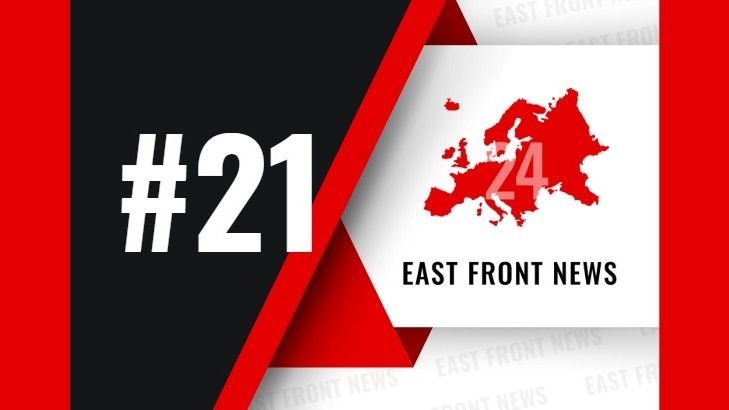East Front News #21: Russian nuclear doctrine update, Conventional IRBM Strike on Ukraine, Danish Navy Stopped a Chinese Ship

Photo. Defence24
East Front News is a weekly newsletter summarizing the past week’s most important events concerning security and the situation in the Central and Eastern Europe region. It includes original opinions and comments, along with key news items significant from a Polish perspective. If you would like to receive this newsletter, please sign up by clicking .
Ukraine hit by an Intermediate Range Ballistic Missile
Ukraine was on Thursday morning attacked by an Intermediate Range Ballistic Missile (IRBM) with several reentry vehicles, which hit Dnipro city. The missile contained no nuclear warheads and the damages are a result of kinetic strike. The Ukrainian Air Force had informed at the beginning that it was an Intercontinental Ballistic Missile (ICBM). Nevertheless, according to Pentagon, the Oreshnik IRBM in question was derived from Russian RS-26 missile, which was officially declared as an Intercontinental Ballistic Missile (though some experts call RS-26 an IRBM), so the characteristic of the Oreshnik missile are not entirely dissimilar to an ICBM. The use of this weapon system, which in operational concept is in many ways similar to „Eurostrategic” missiles used during the late Cold War (including RSD-10 Pioneer, from which RS-26 was derived), marks a significant escalation and in medium to long term brings in a need for NATO response as this is a new Russian capability. Russia used the missile after the Western countries allowed Ukraine to conduct in-depth strikes on Russia territory with systems such as ATACMS and Storm Shadow.
Russian nuclear doctrine update
President Vladimir Putin on Tuesday 19 November 2024 signed a decree updating the Russian Federation’s nuclear doctrine. The time horizon of the signature coincides with the with the authorisation of the Ukrainian side’s use of US long-range missiles on Russian territory. The Kremlin stressed that the changes are the result of adjusting the strategy to »the current realities of armed conflict and the increased involvement of Western countries in the war in Ukraine«. The revised doctrine emphasises that aggression by a non-nuclear state supported by a nuclear state, including the use of advanced weapons, will be considered a joint attack against Russia. Furthermore, indiscriminate attacks with conventional weapons against the Russian Federation or its key allies (Belarus, Iran, North Korea), which could threaten the territorial integrity of these actors, could justify Moscow’s use of its nuclear arsenal. Also new is the assertion that Russia can retaliate nuclear after detecting the launch of a massive airborne attack against it involving, among other things, aircraft, drones or cruise missiles.
Putin stressed, the changes are a response to the »hybrid warfare« waged by the West and the risks posed by the possibility of Ukraine using advanced weaponry supplied by the US, UK or France against Russian targets. Russia, through Putin’s mouth, points out that an attempt to strike strategic targets on its territory would be seen as an escalation to a direct conflict with NATO. Moscow’s actions are primarily aimed at waging information warfare and raising the level of uncertainty in NATO countries and in Ukraine. Russian threats reaffirm the need for countries on NATO’s eastern flank to develop missile defence systems, the need to maintain a US presence on the Old Continent and the essence of a potential extension of the nuclear umbrella over the eastern part of the European continent - be it the US, French or British arsenal.
Meeting of the Big Five and the United Kingdom in Warsaw
On November 19, the foreign ministers of Poland, Germany, France, Italy, Spain and Great Britain met at the Palace on the Isle in the Royal Łazienki Park in Warsaw. The key topics discussed included the future of transatlantic relations, building a strong and resilient Europe, continued support for Ukraine, and the European prospects of Moldova and Georgia. Kaja Kallas, the future head of EU diplomacy, also participated in the talks.
Minister Radosław Sikorski emphasized that Europe must take greater responsibility for its own security, adding that this also involves forming a unified strategy towards the administration of incoming U.S. President Donald Trump. The discussions underscored the importance of EU-Washington cooperation, which is critical for maintaining security in the current geopolitical context, particularly in light of the growing threat posed by the Russian Federation. The presence of former Estonian Prime Minister Kaja Kallas was no coincidence. Sikorski noted that he and Kallas deliberated on the possibility of increasing support for Kyiv. This comes in the wake of the U.S. presidential elections, as the president-elect has signaled intentions to limit arms supplies to Ukraine.
The meeting took place on the 1000th day of Russia’s full-scale invasion of Ukraine, a symbolic choice aimed at underscoring the united stance of European nations in solidarity with the Ukrainian people.
Read more
ICEYE as the Leader of Finland's F-35 Offset Program
ICEYE is set to lead an industrial consortium that will deliver advanced space and analytical technologies as part of Finland’s F-35 Industrial Participation Program. The initiative highlights Finland’s readiness to develop and implement cutting-edge dual-use space technologies that enhance Intelligence, Surveillance, and Reconnaissance (ISR) capabilities in space. ICEYE, a global leader in Earth observation satellites equipped with Synthetic Aperture Radar (SAR), will spearhead the industrial consortium under the Finnish Ministry of Defence’s F-35 Industrial Participation program. The consortium will focus on developing advanced space technologies and ISR capabilities for military users, including the Finnish Defence Forces. The consortium, comprising ICEYE and leading Finnish companies such as Insta, Huld, DA-Group, and the Finnish Meteorological Institute (as a supplier), will collaborate with Lockheed Martin on technology development. The partnership aims to deliver groundbreaking advancements, including AI-driven analytics, mobile ISR reconnaissance stations, advanced data analysis, and high-quality SAR imaging.
SAR systems operate effectively in all weather and lighting conditions, making them particularly valuable in demanding Arctic environments on NATO’s northern flank. Satellite intelligence remains a critical tool supporting military operations across land, sea, and air domains. This new program underscores Finland’s commitment to advancing and adopting dual-use technologies that enhance efficiency and operational effectiveness on the modern battlefield.The partnership between leading innovators in the defence and space industries aims to support the Finnish Defence Forces by improving supply chain security and solidifying Finland’s position as a leader in modern space technologies. These advanced capabilities also open opportunities for further development and expanded collaboration with NATO allies and other partner nations, paving the way for consortium members to boost exports.
It is worth noting that ICEYE, a Finnish-Polish space company, operates the world’s largest constellation of Earth observation satellites equipped with SAR. The company provides near-real-time objective data, granting clients unparalleled access to actionable insights day or night, even under challenging weather conditions.
Read more
Polish WZT-3 ARV in Service with Ukraine
The Ukrainian Ministry of Defence has confirmed the commissioning of the Polish-manufactured WZT-3 ARV in the Armed Forces of Ukraine. Until now, Warsaw had not publicized the transfer of these vehicles to its neighbour.
Poland has provided Ukraine with numerous types of heavy military equipment, often numbering in the hundreds. This support was invaluable, particularly in 2022, when many countries hesitated to offer military aid to Kyiv or did so in a very limited manner. Rumors suggested that Poland’s aid package included support vehicles such as the WZT-2 and WZT-3. However, evidence in the form of photos or videos was lacking. An anticipated list of military assistance from Poland’s Ministry of Defense could shed light on the matter, but despite promises, the list has yet to be published.
Read more
Danish Navy Stopped a Chinese Ship Suspected of Damaging Undersea Cables
The Danish Navy has detained the Chinese bulk carrier Yi Peng 3, which is suspected of damaging telecommunications cables in the Baltic Sea.
The detention took place in the area of Danish territorial waters, in the Danish Straits at the exit of the Great Belt. The detention of the vessel was carried out by the Danish Navy patrol vessel P525. After a few hours, another vessel HDMS Soeloeven, which is specialised for underwater work, reached both vessels. The detention of the vessel occurred on the evening of 19 November. There is no information on whether there was an inspection of the vessel by the Danish MW’s boarding group. The Chinese vessel was sailing from the Russian port of Ust-Luga.
Read more
More Black Hawk Helicopters for the Polish Armed Forces
Deputy Minister Paweł Bejda announced another delivery of helicopters to the Polish Armed Forces.
Poland has purchased four S-70i Black Hawk helicopters from PZL Mielec, a subsidiary of Sikorsky/Lockheed Martin, in 2019. The contract, worth PLN 683 million, provided for their delivery by 2019, subsequent retrofitting and an option for the delivery of four more machines. This option was exercised in 2021, the contract was worth PLN666m. Two helicopters were delivered in 2023 and two more are currently being delivered. Thus, the Polish Special Forces have eight S-70i Black Hawk helicopters, and the contract including the option has been fully executed.
Read more
Poland's Government Adopts Draft Law on Ammunition Production Funding
Polish Council of Ministers has approved a draft law to ensure financing for initiatives aimed at increasing ammunition production, Deputy Prime Minister and Minister of Defence Władysław Kosiniak-Kamysz announced.
Prepared by the Ministry of State Assets (MAP), the draft stipulates that MAP will transfer PLN 2 billion to the Capital Investment Fund (FIK) by the end of this year, using resources provided by the Ministry of Defense (MON). An additional PLN 1 billion for ammunition production funding will be deposited into the FIK account next year.
Read more
Polish Ministry of Defence Announces Billion Contracts in Domestic Industry
During a press conference held alongside the signing of a contract for FlyEye drones, representatives of the Ministry of Defence (MON) announced plans to sign numerous agreements aimed at modernizing the Armed Forces through Poland’s domestic defence industry. Systems supporting artillery alone could receive several billion złoty in funding.
Deputy Minister of Defence Paweł Bejda, speaking alongside Minister Władysław Kosiniak-Kamysz, stated that by the end of the year, 40 contracts would be signed with the domestic defence sector, involving a „substantial amount of money.” Among these is a contract for support vehicles for K9 howitzers, likely covering nine divisional modules. This agreement is expected to be worth nearly 7 billion PLN. For comparison, the executive contract for the purchase of 212 K9A1 howitzers, supporting Polish-made vehicles, amounted to $2.4 billion net. This included 164 newly manufactured units, 48 used ones, as well as a logistics package and ammunition.
Read more
More FlyEye UAVs for the Polish Armed Forces
On Friday, at the Polish Ministry of Defence, a contract was signed for the delivery of 13 FlyEye reconnaissance drone systems to the Polish Armed Forces.
The contract, worth approximately PLN 100 million, was signed in the presence of the Minister of National Defense, Władysław Kosiniak-Kamysz, and Deputy Minister Paweł Bejda. The signatories were Brigadier General Artur Kuptel, head of the Armament Agency (on behalf of the State Treasury), and Piotr Wojciechowski, president of WB Group. Each of the 13 systems includes four drones and ground equipment.
Read more
If you would like to receive this newsletter, please sign up by clicking .
East Front News is a weekly newsletter and article on Defence24.com summarizing the past week’s most important events concerning security and the situation in the Central and Eastern Europe region. It includes original opinions and comments, along with key news items significant from a Polish perspective.
Aleksander Olech, PhD & Jakub Palowski, Deputy Ed. in Chief










